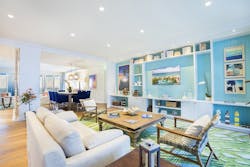- The needs of the end user
- The wants of the client
- The aesthetic pulling them all together.
But what about spaces that cater to a larger fan-base?
The desire for destinations is growing and it looks like it will only continue. With a growing population of people who want experiences rather than things, the market for destination hotspots is at an all-time high, particularly in the hospitality and restaurant markets.
Pat McBride, CEO of The McBride Company, with locations in Manchester Center, Vt., and Miami, knows what it takes to create a haven for those looking for an ideal brand experience. The design firm has built its name in the hospitality and leisure brands, creating spaces for the likes of Jimmy Buffett’s Margaritaville, Hard Rock Cafes, and The Breakers Palm Beach. From restaurants to movie theatres to resorts, The McBride Company focuses on taking visitors to the next level.
The Key Differences between Destination and Location
An important guideline in creating a destination experience versus a location is keeping the expectations of the fan base in mind.
However, the line McBride and his team have to carefully toe is between creating a destination for both the hardcore fans of a brand and those looking to experience it in a more low-key manner.
“It’s a matter of degree because you have to figure that in these brands there are certain elements that a core audience wants that must be there every single time,” he explained.
He continued, “By the same token, think about professional sports: I think the statistic is that of all the people that say they are dedicated professional football fans only 20 percent have ever been to a professional game; the rest of the [audience] wants to experience it. You have to be careful that you deliver on the expectation that is there for those very brand-loyal individuals but you can’t go so overboard with it that you turn off the other 80 percent of people you hope to convert [to the brand].”
Creating a Collection Rather than a Chain
As McBride explained, “We don’t consider them to be a chain; we consider [the locations] to be a collection. In a collection, if you collect books, art, eggs—whatever you collect— the variety is what makes it interesting and unique. There’s a thread that ties [the collection locations] together, but they’re different.
“We try to find different solutions in each property that not only reflect the brand but that reflect the locale as well.”
However, there are always details the customer expect no matter where they are, such as the reliability that there will be a USB plug on the bedside table, the same types of soaps in the bathroom, or the same pillow and mattress that frequent guests have come to love.
Those details, McBride said, are the base of any collection’s design. “Those things should never change because they were developed to make the guest feel comfortable from location to location. Think of that as the base. Now the design can layer on top of that. That’s where you have more freedom.”
Somewhere between Atmosphere and Kitsch
One example McBride pointed to was the use of a 14-foot-tall sculptural flip-flop that stands in the Hollywood Beach Resort in Hollywood, Fla.—part of the Margaritaville Hospitality Group. Designed with sculptor Claes Oldenburg’s work in mind, the flip-flop is treated as a piece of art and a focal point. The relaxed vibe of the hotel is heightened by the subdued, beachy colors throughout the lobby so that it doesn’t become overwhelming.
“[Visitors] do have an expectation so if you don’t deliver the color palette, the materials, and the things that transport that person into the environment you’re trying to create, you’ve missed it,” he said. “Yet, if you make it so kitsch you’ll wear out your welcome really quickly.”
Read More in Interior Design: Ink Minx the Traveling Tattoo Parlor
Long-Term vs Short-Term Destinations
The amount of “kitschy” material one can add to a space depends on how long the user is expected to remain in the environment. McBride pointed out the instances of when restaurants are able to combine brand presence without overwhelming guests; part of the charm is the over-the-top nature of the space.
However, in locations such as resorts and hotels where the guest will be staying for long periods of time, extensive branding can take its toll.
“When you’re dealing with a hotel where people are going to stay for days, not hours, you have to make sure that what you do is not kitsch. That means you don’t put up props and dressings, the colors need to be beautiful and evocative of the brand, but at the same time you have to make sure [these elements] don’t wear out their welcome. You can’t really do jokes and you can’t do kitsch in environments that [the guest] is staying in for more than a couple of hours. If you do, the first time [visitors] come in [they] see something and say, Wow, this is fun!’ but by the fourth time it becomes, ‘I’m sort of over this thing; I don’t want to see it again.’”
About the Author

Kadie Yale
Former Editor-in-Chief
Kadie Yale holds a BA in Industrial Design from San Francisco State University and a MA in Decorative Art History and Theory from Parsons the New School. In her role as editor-in-chief from 2015-2018, she led the interiors+sources team in creating relevant content that touches on sustainability, universal design, science, and the role of design in society.
